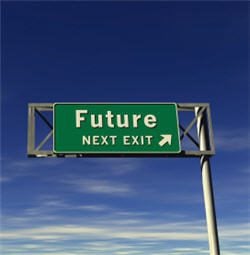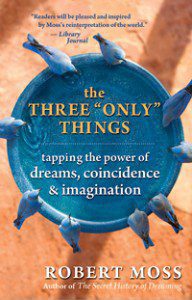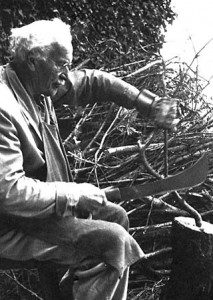 Our dreams are constantly coaching us for challenges and opportunities that lie ahead of us on the roads of life. It’s possible that we rehearse everything that will take place in the future in our dreams, though we forget most of it.
Our dreams are constantly coaching us for challenges and opportunities that lie ahead of us on the roads of life. It’s possible that we rehearse everything that will take place in the future in our dreams, though we forget most of it.
Across human evolution, dreaming has been a vital survival mechanism. In the days when we were naked apes without good weapons, our dream radar – our ability to scout across both space and time – often enabled us to avoid becoming breakfast for saber-toothed tigers or leathery raptors.
A recent theory posits that dreaming prepares us for challenges by putting us through frequent workouts in threat simulation, helping us to develop the reflexes and responses that will get us through.
I suspect our relationship with the future in dreams is much deeper and more important than this. In dreaming, we have access to the matrix in which the events and circumstances that will manifest in our physical lives have their origins. We can not only see future events; we can choose – to varying degrees, and according to our level of consciousness – which among many possible future events will manifest.
It’s my impression that we are dreaming the future all the time.
If you adopt the practice of recording your dreams and comparing the dream data with subsequent events, it won’t take long for you to notice some match-ups. The incidents you preview in your dreams may be trivial or terrifying, blah or wonderful. They may be events in your own life, or events in the future history of the world.
Our dreams start preparing us for what life will give us months, years, even decades ahead of events. In dreams, we have several kinds of engagement with the future:
Precognitive Dreams
Through precognition, we see events and circumstances ahead of time, as they will be played out. A precognitive dream may be literal, or symbolic or both. For example, a dream of a tsunami might turn out to be both a preview of a literal disaster and advance notice of an emotional storm that will hit with the force of a tsunami. We may not understand what we have seen in a precognitive dream until a physical event catches up with that dream. It may also be difficult for us to understand what we have seen because we are looking at things from a certain angle, perhaps the perspective of a different person. But with practice, we can learn to recognize markers that a dream relates to future events, and we can then move to clarify and use the dream information.
Early Warning Dreams
Dreams may contain early warnings of a possible future development we may not want – a crisis at work, the bust-up of a relationship, a health problem, a car accident. We may not want to focus on any of these unpleasant possibilities. But if we are willing to study what an early warning dream is telling us, we will often find that it is giving us vital information that can help us avoid a possible future problem if we take appropriate action.
Sometimes we dream the future for the benefit of another person, even a great cause. What will then happen depends whether we can find an effective way to get the dream information to the person who can best act upon it.
Early Opportunity Dreams
Early opportunity dreams may also require action if we are going to manifest a future we’ll enjoy. You dream you are in your ideal home, or doing the work that nourishes your soul and your bank account, or you are with your soulmate, who is someone you have not yet met in the regular world. These dreams may be inspiring and encouraging, but you won’t want to leave them floating away from your physical life like helium balloons that have lost their strings. You’ll want to figure out what practical action you can take to move decisively in the direction of that happy dream.
Choosing Alternate Event Tracks
Any future we can see (in dreams or through wakeful intuition) is a possible future. We can influence the odds on the manifestation of a
specific future event. While it may seem impossible for an individual to change certain future events perceived in dreams – like a natural disaster or death at an advanced age – it may still be possible to work with the dream information in a useful way: for example, to alert friends not to go on vacation in the place where the dreamed hurricane will hit, or to help someone whose death is near, and the family, to meet that situation with grace and closure.
As dreamers, we discover and inhabit the true nature of time, as it has always been known to dream travelers and is now confirmed by modern science. Linear time, as measured by clocks, and experienced in plodding sequences of one thing following another, always heading in the same direction, is an illusion of limited human awareness, at best (as Einstein said) a convenience. In dreaming, as in heightened states of consciousness, we step into a more spacious time, and we can move forwards or backwards at varying speeds.
We not only travel to past and future; we travel between alternate timelines.
With growing awareness, we can develop greater and greater ability to choose the event track – maybe one of infinite alternative possible event tracks – that will be followed through a certain life passage, or even the larger history of our world.
This may be a case of the observer effect operating on a human scale. It is well understood that at quantum levels, deep within subatomic space, the act of observation causes plucks a specific phenomenon out of a bubbling cauldron of possibilities. It may be that, in the cauldron of our dreaming: through the act of observation, we select a certain event track that will begin to be manifested in the physical world. By a fresh act of observation, or re-visioning, we can then proceed to alter that event track, or switch to an entirely different one.
–
Adapted from Robert Moss, The Three “Only” Things: Tapping the Power of Dreams, Coincidence and Imagination published by New World Library


